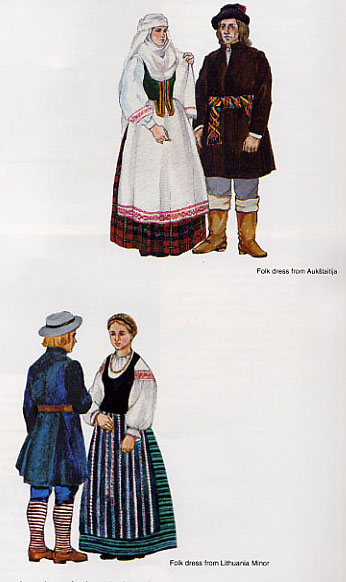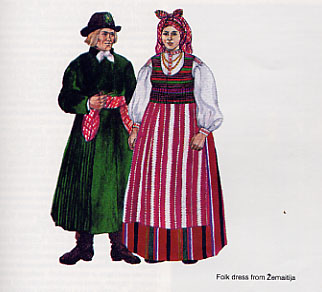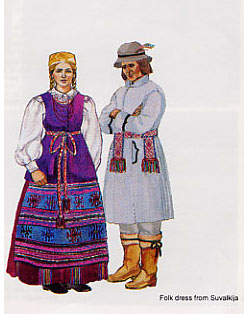Kauen (Kaunas) - Ghetto and internment camp; subcamp Prawienischken; (http://www.ushmn.org/kovno/intro/intro.htm)
Background history on Lithuanians in World War II:
Excerts from Hearken Then Judge Juozas Pasilaitis,
published by Patria Tübingen, printed by J.F. Steinkopt, Stuttgart Germany,
actual date not given but late in 1947.
General massacre committed by the Bolsheviks in the sugar factory of Panevezys on 26th June 1941
"In the night of July 11-12 1940, more than 2,000 Lithuanians were seized unexpectedly by the Soviet NKVD in Lithuania. These people belonged to the elite of the country. They were leaders of political groups and cultural organizations, former members of the government, editors of newspapers, and well-known journalists.

General massacre committed by the Bolsheviks
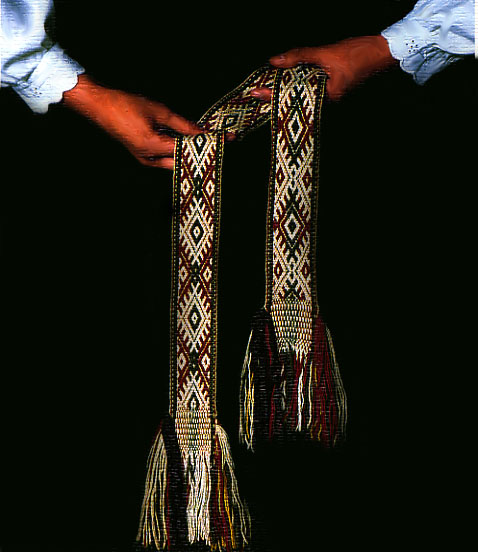
"On Oct 1 1941, the Soviet Union and Germany signed a treaty according to which people could be exchanged; persons of German extraction could repatriate to Germany and Lithuanians from Germany could move to Lithuania. Correction: The Soviet-German resettlement agreements were signed on January 10 and 11 of 1941. They dealt with the selection, resettlement and financial reimbursement procedures. After the war began the relationship was disjoined on bad terms. Germans searched Soviet embassies in Paris and Berlin, after which there were no direct contacts between them. For your reference, these documents were published in Documents on German Foreign Policy, series D, volume 12, and Documents on Foreign Policy of the USSR volume 23 David G. Ryzhenkov "This was a legal change to escape from the Soviet regime and the Lithuanians seized this opportunity, especially those families whose male members had already been imprisoned and whom they hoped to save in this way. Forging papers or using every other means to attain their end, along with true Germans about 40,000 true Lithuanians succeeded in escaping from the Soviet regime under the cloak of repatriaiton.
"When the war broke out between the Soviet Union and Germany, those of the repatriates who had been nationalized by Germans and whose passports had been stamped with the letter "O" (Ost=East), were sent to Lithuania for colonization purposes, while those who had not accepted German citizenship were ill-treated and even not allowed to leave Germany.
"Attacking Russia on June 22, 1941, the Germans entered Lithuanian territory. To their greatest surprise they found the National Government of Lithuania established, the administration of the country taken up by it and the Bolsheviks turned out of Vilnus and Kaunas, the principal cities of the Republic. Refusing to comply with German orders, the National Goverment was at once abolished by force and a German civil government installed.
"The Lithuanians boycotted German efforts to organize a Lithuanian SS-legion, then men and women were seized by force - at home, in streets, picture houses, theatres, and even churches. In June 1944 and some time after this action was more intensive than ever. Then people were seized to dig trenches in East Prussia, or, the front moving to the interior of Germany, to serve in the Luftwaffe (air force).
"Thus the Lithuanians refugees, consisting of about 100,000 persons, got to Germany, Italy, Yugoslavia, France, Norway and Denmark. "
"The German front-line having broken through and the Soviet army occupying Lithuania for a second time in July 1944, vast masses of Lithuanian inhabitants, part of them on receiving evacution orders, others led by the sense of self-preservation, withdrew from a second Soviet invasion. Part of them tried to get to Sweden but only some hundreds were lucky enough to reach that country. German war-ships overtook most of the fugitives, put them in jail or took them to forced labour camps. The majority of Lithuanian refugees, however, moved towards the only country within reach that was not occupied by the Soviets, namely to Germany.
There were 53,000 Lithuanian DPs in Germany
"Movements from one zone of occupation to the other having ceased, we find 18,000 Lithuanians in the British Zone (this figure includes residents of camps as well as people living in private flats without UNRRA care), 32,000 in the American, and 3,000 in the French Zone of occupation.
"A great many fugitives in East Prussia, Pomerania, Mecklenburg and Saxony fell into the hands of the Russians. Formally they have been or are still to be repatriated, but actually only the old ones reach home while the able-bodied have been transported to Russia to work there.
In Lithuania under Soviet occupation
"During one year, 12,000 Lithuanians, of whom 5,000 were murdered, were put in prison; in several cases 500 people were shot at once (Praveniskiai, Chervene are famous for that) on June 14-21, 1941, 40,000 Lithuanians were deported to Russia. The heads of families were separated from the rest; mothers were torn away from their children. 50% of the deported perished.
"This is the reason why the exiled Lithuanias cannot repatriate. They do not and will not return home so long as foreign occupation lasts in their native country."
The DPs in Germany
"Only younger people were taken to Germany as slave labourers. Older people got to Germany either in consequence of forced evacuation or having fled with their families from the Bolshevik regime.
"Only younger and more energetic people and their dependents determined to emigrate voluntarily, thus saving themselves from the Bolshevik regime.
"Above 8% of the Lithuanian DPs are derived from farmers. 72% are effectively ablebodied; 25% are children and youth from 0-17 years of age. Only 3% are over 60 years of age.
"3,875 persons (13% of the total number of Lithuanian DPs in the American zone of occupation in Germany and Austria have learned a practical trade. These people have learned to be drivers, auto-mechanicians, electro-mechanicians, carpenters, tailors, shoemakers, nurses and the like.
"Most of the people who received university education and whose professions could hardly be applied to in emigration, as for instance jurists, economists, and former administrative workers, have acquired ordinary practical trades. "
Housing in a DP camp
"Two or three and sometimes even more families are housed in one room. This room serves every purpose. Very often families separate their quarters with blankets, wishing to have a least a corner to themselves where they may hide from other people's eyes.
"In addition take the whimpering and crying of children, the various parties in the room and you will understand why the DPs have no peace and why such conditions produce a very sad effect on the moral and health of people in general and the young in particular."
Supplies in a DP camp
"The DPs are supplied with food, footwear, and clothing from IRO stocks. They get neither ration cards nor order permits for clothes or footwear from the Germans.
"DP food is divided into several categories. The majority of people get the normal consumer ration which is the base unit of food. "
Flour, grits, fresh meat, skimmed milk, cheese, fats, sugar, salt, potatoes, vegetables or fruit (often missing) coffee, egg powder, soup powder.
"The daily ration consists of less than 2,000 calories. A moving / walking / person who does not do anything needs 2,300-4,000 calories daily to preserve his health."
"The basis of DP food, then (satisfying and covering a person's requirment for calories) are carbohydrates and undigestible waste foods.
"The lack of vitamins is also badly felt. The amount of supplied vegetables is minimal and these being generally cooked in soups, no vitamins remain. Moreover, mineral salts are also lacking for the same reason. The results of the unvaried diet are anemia, bad teeth and the like."
"The largest part of the supplied articles has been donated by citizens of the United States. These articles are often small rather worn out clothes and shoes. In most cases, the clothing has to be altered or made to fit children.
Health
"The Lithuanians DPs are a northern type. Their hair is mostly blond or brown, their eyes are blue, their stature middle-sized.
"The Lithuanians are chiefly a nation of farmers and therefore they are in general in good health. The number of inherited disease is relatively small, the percentage of mental and nervous cases of this kind is 7 times less than among the Germans.
"In spite of disasrous experiences - starvation, bad housing, hard work in German workshops, terrible air-raids and the like - the majority stayed comparatively healthy.
Owing to unsatisfactory feed, the following diseases have been noticed: undernourishment 17%; avitaminosis 9%; and tuberculosis .8%. Recently disease of the respiratory and digestive organs as well as cutaneous disease have been noticed.
Health
"That the DPs are willing to work is proved by their numerous offers to work for the Americans. In many cases the number of DPs, ready to join the Labour Service or Guard Comapnies was ten times larger than requied by the U.S. Army.
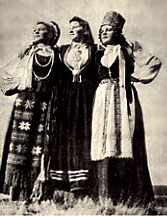
Why Do People Not Return Home?
They are not going to return to their native countries under the existing conditions there. They wish to go abroad and to leave Europe behind where they experienced and suffered so much and where they are so near those who caused all their misfortune. The removal of part of the DPs from the British zone to England proves that this is possible and that the DPs are in favor of the scheme. The Lithuanian DPs are determined to emigrate and would gladly go to countries ruled by Anglo-Saxons where the climatical conditions are favourable and where their characters would adjust themselves more easily to the local conditions and the people who offered them a home. "
From an article about Lithuanians in DP camps
by Frank Passic and Steven A. Feller:
"Two distinct themes emerged regarding the "repatriation" of DPs, most of whom were housed throught the western zones of Austria and Germany. First, many Jews who survived the Nazi holocaust wished to migrate to Israel, then known as Palestine. However, the British Mandate allowed only 1,500 Jews to enter Palestine each month, thus delaying the relocation of Jewish DPs.
"The control of Jewish DP camps rested with the American Jewish Joint Distribution Committee (AJDC) which, although organized in cooperation with UNRRA, encouraged migration to Palestine.
"Second, while the Jewish people knew where they wanted to be relocated, Eastern Europeans, particularly Lithuanians, had definite ideas about where they did not want to relocate. When the Nazis retreated from Lithuania in 1944, thousands of Lithuanians fled their country in advance of the occupying Soviet army, knowing of the terror to come.
"By the end of the war, roughly 70,000 Lithuanians had made their way into Germany and Austria. At first, the Allied powers thought these people took up residence in western Germany against their will and that they would prefer to return to their homeland, but such was not the case.
"The Allies, including the United States initially accused Lithuanian DPs of being former Nazi sympathizers. They later realized that the actual reason for their reluctance to return to their country was based on the fact that because they witnessed the Soviet annihilation of Lithuania in 1940-41, they certainly would be executed or deported to Siberia if they set foot on their native soil. Still, to the horror of many, some were forcibly sent back by the Allies, never to be heard from again.
"Accordingly, suspician and distrust ran high in DP camps housing Lithuanian refugees. A large percentage of the inhabitants were professional--physicians, engineeers, jurists, teachers, public officials, artists and clerk--and would have been targeted instantly by the Soviet occupational regime if they returned home.
"Gradually, western nations accepted the reality of the situation and opened their doors to large numbers of immigrants from DP camps. Many DPs made their way to new lives in the US, Canada, Australia and Great Britain, while Jewish refugees who before had languished in Hitler's concentration camps, witnessed the unfolding of the Jewish state of Israel.
"Following the war, many DP camps issued their own internal currency, which was used to pay workers and others within their confines. Generally, the money was spent at the canteen or "P.X." for needed supplies. However, one must bear in mind that each camps's money was redeemed and destroyed and residents had little cause to save it. Thus, many notes described in numismatic literature are one-of-a-kind and all are considered very scarce to rare, bringing high premiums in today's market."
I saw your website posted on Missing Links. The Balzekas Musuem of Lithuanian Culture, has an extensive collection of Lithuanian DP camp items, including camp booklets and publications, lists of residents, an extensive library and is a great resource. The Balzekas Museum is a primary source for original material. They have many files on each camp filled with photos and and items about Lithuanian DP camps. Balzekas Musuem of Lithuanian Culture
6500 S. Pulaski Road, Chicago, IL 60629
(773) 582-6500. E-mail: editor@lithuanianmuseum.org
The Library is the largest Lithuanian resource and reference center outside Lithuania. It holds over 50,000 books, 1500 titles of periodicals, thousands of manuscripts, pamphlets, clipping files on artists, scholars, politicians and other prominent 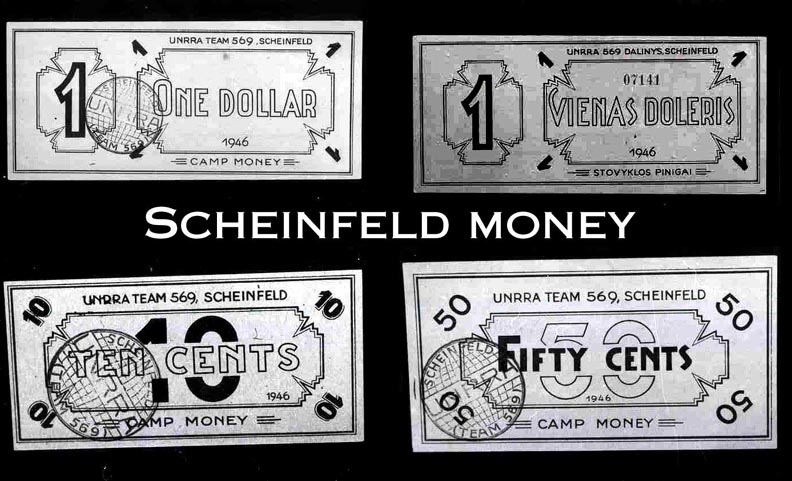 people of Lithuanian descent, records of hundreds of cultural, political, social and religious Lithuanian organizations. Photo and Music archives are overcrowded as well.
I am one of the founders of the Lithuanian Numismatic Association
and have written several articles about DP Camp money, including Lithuanian camps.
My article, "Displaced Persons Camp Money" was published as the cover story in
the August, 1984 issue of THE NUMISMATIST, published by the: American Numismatic Association,
818 N. Cascade Ave, Colorado Springs, CO 80903
E-mail: editor@money.org.
I would suggest getting a copy that issue for your files, as it gives the history of camps such as Scheinfeld, Ludwig-Dillingen, Luitpold-Dillingen, Bad Worishofen and others. I serve as the numismatic curator at the Museum, and also help in the Genealogy Department. I collect DP camp money and display it at numismatic shows here in the U.S.
Here is a photograph of Lithuanian DP Camp Money at Scheinfeld. The notes are bi-lingual: Lithuanian on one side; English on the other.
people of Lithuanian descent, records of hundreds of cultural, political, social and religious Lithuanian organizations. Photo and Music archives are overcrowded as well.
I am one of the founders of the Lithuanian Numismatic Association
and have written several articles about DP Camp money, including Lithuanian camps.
My article, "Displaced Persons Camp Money" was published as the cover story in
the August, 1984 issue of THE NUMISMATIST, published by the: American Numismatic Association,
818 N. Cascade Ave, Colorado Springs, CO 80903
E-mail: editor@money.org.
I would suggest getting a copy that issue for your files, as it gives the history of camps such as Scheinfeld, Ludwig-Dillingen, Luitpold-Dillingen, Bad Worishofen and others. I serve as the numismatic curator at the Museum, and also help in the Genealogy Department. I collect DP camp money and display it at numismatic shows here in the U.S.
Here is a photograph of Lithuanian DP Camp Money at Scheinfeld. The notes are bi-lingual: Lithuanian on one side; English on the other.
Best wishes,
Frank Passic 01 Apr 2003
900 S. Eaton St. Albion, MI 49224
E-mail:albionfp@hotmail.com
Book: World WAR II Russian-German Occupations in Lithuania by Aleksadras Kublias, in English, 1997 $35.00
"The second Soviet occupation lasted from 1944 to 1990. Lithuanian patriots did not cooperate with either of the agggressors; they fought fiercely against both Hitler's troops and the Soviets. Resistance against the second Soviet occupation was especially persistant from 1944-54."
"From 1940 to 1958 Lithuania lost 1 million people through emigration, deportation or death; only in 1969 did the population once again reach pre-war levels. In 1958-59 267,000 people, mostly Russians or Russian speakers, immigrated into Lithuania."
Quotes and clothing illustrations (by Laisvi Asmonaitiene) are from a beautiful, colorful booklet called Lithuanian Roots, an Overview of Lithuanian Traditional Culture published by Lithuanian Folk Culture Center, Ethnic Culture Department
B. Radvilaites 8, Vilnius,
Tel. (8-22) 612540, 611190
Fax 224033
The Folk Culture Center researches ethnic culture, helps preserve traditions and customs, produces scholarly and educational works and records present-day Lithuanian folk culture through video film, audio, photographs and written material.
Lithuanian church addresses
http://www.polishroots.com
Archives in Lithuania
http://www.polishroots.com
Research links:
http://www.theatrelibrary.org
Lithuianians to South Australia
http://salithohistory.blogspot.com
Names of Settlements in Lithuania Minor and search page
Hi,
I'm trying to find out my father's history pre-1949 when he was in Germany as a DP from Poland. He was born in Sudvariskiau, Lithuania, was taken to labor camp in Poland either by Russians or Germans, then taken to Germany by Germans. Later he worked for US and was housed in a DP camp.
We know from my mother's papers that Juozas Navickas was last processed in FunkKaserne in Munich Germany before coming to US through the IRO. Is there anyway of finding where he was prior to FunkKaserne? and how he came to Germany from Poland and Lithuania?
Any help or direction in finding information would be greatly appreciated. Heidi Chrambanis DP: Lithuanian Immigration to Canada After the Second World War Danys, M. (1986), Toronto: Multicultural Historical Society of Ontario.
Great website, btw! Kind Regards, Julia Dicum
